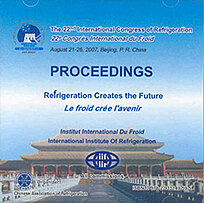
Résumé
Mixed-refrigerant fractionation refrigeration system is applied in low temperature instruments in order to let up the volume and reduce the weight of refrigeration system. In this paper, 2-stage condenser-evaporator, high and low temperature regenerators are put together to improve on a combined heat exchanger. For using fluid seal as pumps, U-bend tubes are designed at the liquid outlet of the condenser and every separator. On the basis of these, the condensing pressure, evaporation pressure, minimum evaporation temperature, maximum starting pressure of different ratio non-azeotropic mixed-refrigerant are discussed through experiments respectively. Then the experiments of temperature dropping between the former series-parallel connection and the improved system of single-stage compression, 2-stage fractionation refrigeration system are predicted in a low temperature cooling circulation instrument with 5 liters/-80°C. The results indicate the effect of R-134a/R-23 is better than the others for its minimum refrigerating temperature and the temperature dropping of the improved system is faster, so it can replace cascade refrigeration system.
Documents disponibles
Format PDF
Pages : ICR07-B2-99
Disponible
Prix public
20 €
Prix membre*
Gratuit
* meilleur tarif applicable selon le type d'adhésion (voir le détail des avantages des adhésions individuelles et collectives)
Détails
- Titre original : The research on mixed-refrigerant fractionation refrigeration system for low-temperature instruments.
- Identifiant de la fiche : 2008-0009
- Langues : Anglais
- Source : ICR 2007. Refrigeration Creates the Future. Proceedings of the 22nd IIR International Congress of Refrigeration.
- Date d'édition : 21/08/2007
Liens
Voir d'autres communications du même compte rendu (839)
Voir le compte rendu de la conférence
Indexation
-
Thèmes :
Frigorigènes, frigoporteurs : généralités;
Physique à basse température;
Transport et manipulation des fluides cryogéniques;
Cryogénie: sécurité, instrumentation et métrologie;
Mélanges - Mots-clés : Système frigorifique; Cryostat; Basse température; Conception; Mélange zéotropique; Instrument de mesure; Cryogénie; Frigorigène
-
Heat transfer through superinsulation from ambi...
- Auteurs : HIRSCHL C., KRÁLIK T., LAA C., et al.
- Date : 17/07/2006
- Langues : Anglais
- Source : Multiconference CryoPrague 2006 (9th Cryogenics 2006, ICEC 21, ICMC'06)
- Formats : PDF
Voir la fiche
-
Liquid hydrogen level sensors based on MgB2.
- Auteurs : HABERSTROH C., DEHN G., KIRSTEN K.
- Date : 17/07/2006
- Langues : Anglais
- Source : Multiconference CryoPrague 2006 (9th Cryogenics 2006, ICEC 21, ICMC'06)
- Formats : PDF
Voir la fiche
-
Comparison of cryogenic temperature measurement...
- Auteurs : SÜSSER M., WÜCHNER F.
- Date : 22/07/2002
- Langues : Anglais
- Source : Proceedings of the nineteenth International Cryogenic Engineering Conference. ICEC 19.
Voir la fiche
-
JAUGE DE HAUTE SENSIBILITE POUR LES MESURES DE ...
- Auteurs : COLLAUDIN B., HEBRAL B.
- Date : 08/09/1986
- Langues : Français
- Formats : PDF
Voir la fiche
-
HIGH RESOLUTION EXTENSOMETERS FOR USE IN CRYOGE...
- Auteurs : KOMAREK P., et al.
- Date : 10/08/1991
- Langues : Anglais
- Source : New challenges in refrigeration. Proceedings of the XVIIIth International Congress of Refrigeration, August 10-17, 1991, Montreal, Quebec, Canada.
- Formats : PDF
Voir la fiche
